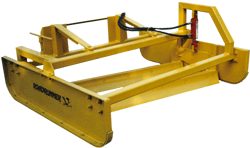SFish
Silver Member
Flyer:
I improved and maintained over 1/2 mile of gravel roads with a Ford NH 1320 (similar size as your rig) and a 60" box blade that I purchased new in 1994. There were level and very steep sections of the road and it did everyting I wanted with manual adjustments of the blade and no added weights (but loaded tires).
I recently moved to a new place with 3 times the length of gravel roads and purchased a larger tractor (JD 3320) with a Top-and-tilt for the new 72" box blade. I agree with everything Patrick said, the ability to dynamically adjust the blade while working makes a major difference to my productivity and greatly reduces my irritability factor. I wish I had purchased the extra hydraulics for the Ford. Considering the overall cost of the tractor the extra expense is a big productivity bargain.
One feature that Patrick didn't mention is that if you don't get the extra hydraulics to lower and raise the scarifiers, you can set them to just touch when the blade is level and lower them by tilting the blade forward with the top cylinder for ripping up a section without having to get off the tractor. Raising and lowering scarifiers manually is a pain. Whether or not you get a pro to fix your road, a box blade with hydraulics will make maintenance much easier.
Steve
I improved and maintained over 1/2 mile of gravel roads with a Ford NH 1320 (similar size as your rig) and a 60" box blade that I purchased new in 1994. There were level and very steep sections of the road and it did everyting I wanted with manual adjustments of the blade and no added weights (but loaded tires).
I recently moved to a new place with 3 times the length of gravel roads and purchased a larger tractor (JD 3320) with a Top-and-tilt for the new 72" box blade. I agree with everything Patrick said, the ability to dynamically adjust the blade while working makes a major difference to my productivity and greatly reduces my irritability factor. I wish I had purchased the extra hydraulics for the Ford. Considering the overall cost of the tractor the extra expense is a big productivity bargain.
One feature that Patrick didn't mention is that if you don't get the extra hydraulics to lower and raise the scarifiers, you can set them to just touch when the blade is level and lower them by tilting the blade forward with the top cylinder for ripping up a section without having to get off the tractor. Raising and lowering scarifiers manually is a pain. Whether or not you get a pro to fix your road, a box blade with hydraulics will make maintenance much easier.
Steve
Last edited:
